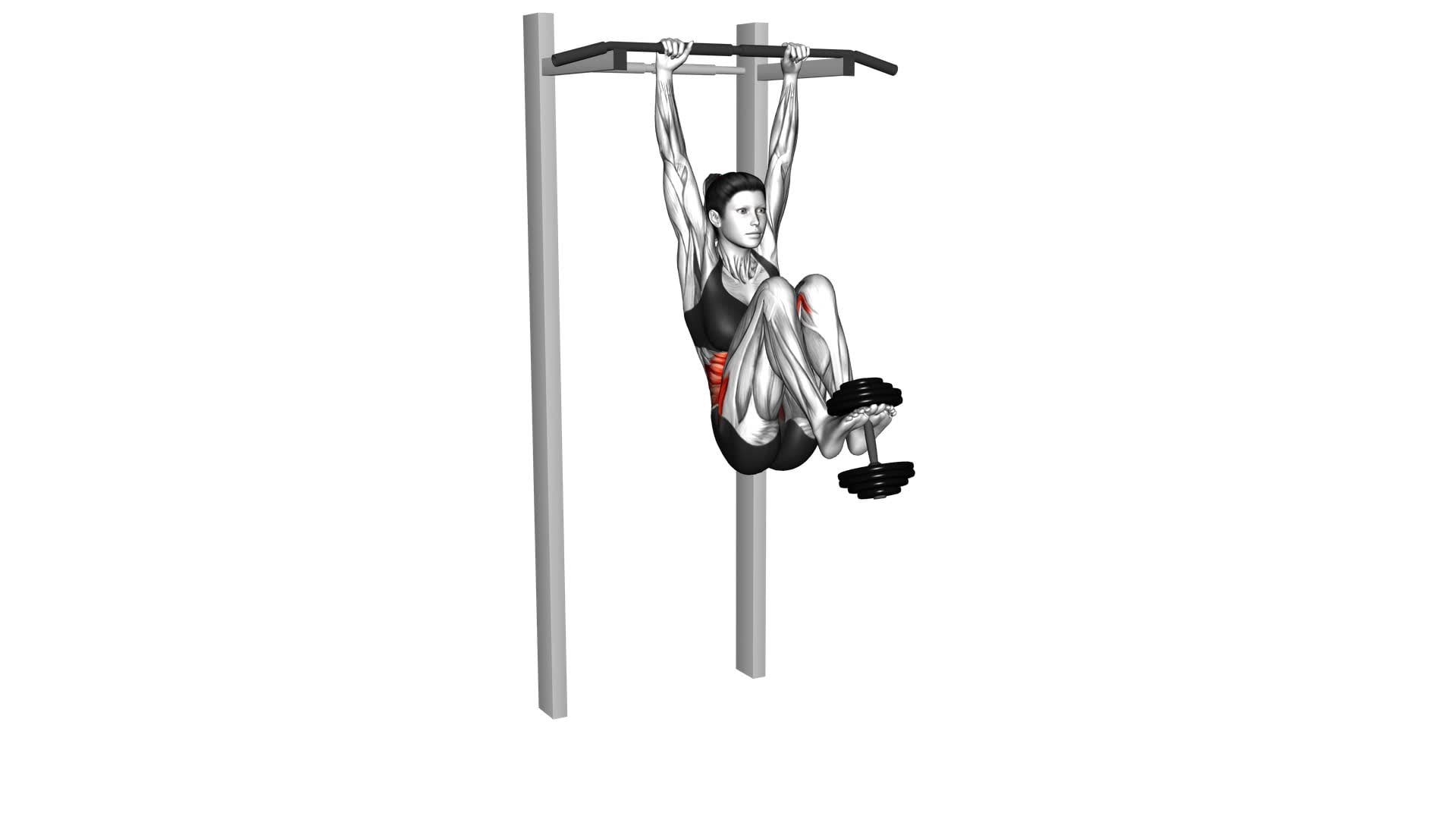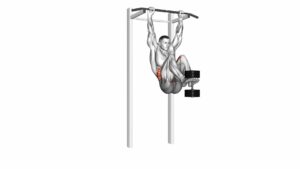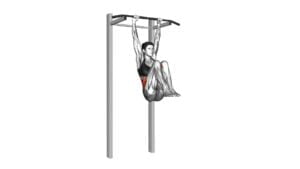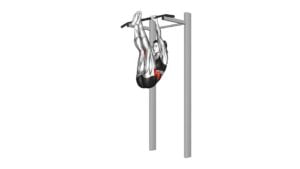Weighted Hanging Leg Hip Raise (female) – Video Exercise Guide & Tips

Looking to tone your lower abs and strengthen your hip flexors? Look no further than the weighted hanging leg hip raise.
Watch This Exercise Video
In this video exercise guide, you'll learn the proper form and technique, as well as variations and modifications for this challenging move.
Watch the video and follow along for expert tips to get the most out of your workout.
Get ready to feel the burn and take your fitness to the next level!
Key Takeaways
- Weighted Hanging Leg Hip Raise targets the hip flexors and lower abs while strengthening and toning these areas.
- This exercise increases core strength, improves stability and balance, and enhances hip mobility and flexibility.
- Modifications and variations of the exercise can be made to accommodate different fitness levels and preferences.
- It is important to maintain proper form and technique, engage the core and avoid swinging or using momentum during the exercise.
Benefits of Weighted Hanging Leg Hip Raise
You can experience numerous benefits from incorporating weighted hanging leg hip raises into your workout routine. This exercise primarily targets the hip flexors and lower abs, helping to strengthen and tone these areas. By adding weights to the exercise, you increase the resistance and challenge your muscles even more.
One of the main benefits of weighted hanging leg hip raises is increased core strength. This exercise engages your entire core, including your abs, obliques, and lower back muscles. As a result, you can expect improved stability and balance in your everyday activities and other exercises.
Another benefit is improved hip mobility. The hanging position allows for a greater range of motion in your hips, helping to increase flexibility and reduce the risk of injury. Additionally, incorporating variations and modifications for the weighted hanging leg hip raise can further enhance the benefits. For example, you can try alternating leg raises or adding a twist at the top of the movement to engage different muscle groups.
Equipment Needed for Weighted Hanging Leg Hip Raise
To perform the weighted hanging leg hip raise, you'll need a few essential pieces of equipment.
First, you'll need a pull-up bar or a sturdy bar that can support your weight.
Additionally, you'll need a weight plate or dumbbell to add resistance to the exercise.
If you don't have access to a pull-up bar, there are alternative exercises you can do to target the same muscles.
Essential Equipment for Hip Raise
To perform the weighted hanging leg hip raise exercise, you'll need essential equipment. Here are the items you'll need:
- Pull-up Bar: A sturdy pull-up bar is necessary to hang from while performing the exercise. Make sure it can support your body weight.
- Weighted Vest or Ankle Weights: To add resistance and make the exercise more challenging, you can use a weighted vest or ankle weights. Start with a lighter weight and gradually increase as you get stronger.
For easier modifications for beginners, you can try the following:
- Bent Knee Variation: Instead of keeping your legs straight, you can bend your knees and raise them towards your chest. This modification reduces the intensity and makes it easier to perform.
- Assisted Variation: If hanging from a bar is too difficult, you can use a hanging leg raise machine or resistance bands to assist you in lifting your legs.
Remember these tips for proper form and technique:
- Keep your core engaged and your lower back pressed against the bench or floor.
- Control the movement and avoid swinging your legs.
- Exhale as you lift your legs and inhale as you lower them.
With the right equipment and proper technique, you can effectively target your hip muscles and strengthen your core.
Alternatives to Weighted Hang
One alternative to the weighted hang for the weighted hanging leg hip raise exercise is using a resistance band. This is a great option for those who don't have access to the necessary equipment or prefer to use their bodyweight for resistance.
To perform the exercise with a resistance band, simply attach one end of the band to a secure anchor point, such as a door frame or sturdy pole, and loop the other end around your ankles. From there, assume the starting position with your body hanging from a pull-up bar or similar apparatus. Engage your core and lift your legs up towards your chest, squeezing your abs at the top of the movement. Slowly lower your legs back down and repeat for the desired number of repetitions.
This alternative exercise provides a similar challenge to the weighted hang, targeting the lower abs and hip flexors while also engaging the muscles of the upper body for stabilization.
Other bodyweight options for the weighted hanging leg hip raise include performing the exercise with bent knees or incorporating a knee tuck at the top of the movement. These variations can help to make the exercise more accessible to beginners or those with limited mobility.
Remember to always maintain proper form and engage your core throughout the exercise to maximize its effectiveness.
Proper Form and Technique for Weighted Hanging Leg Hip Raise
You can achieve proper form and technique for the Weighted Hanging Leg Hip Raise by focusing on your core strength and utilizing a controlled double leg raise motion.
To help you perform this exercise correctly, here are some tips:
- Weighted Hanging Leg Hip Raise modifications:
- Start without weights: If you're a beginner, it's best to begin with bodyweight only to ensure proper form and technique.
- Use ankle weights: As you progress, you can add ankle weights to increase the challenge and intensity of the exercise.
- Tips for beginners:
- Engage your core: Before starting the movement, make sure to engage your core muscles by pulling your belly button towards your spine.
- Control the motion: Slowly raise your legs while focusing on keeping your core tight and preventing any swinging or momentum.
- Maintain proper alignment: Keep your back straight and avoid arching or rounding your spine during the exercise.
- Breathe properly: Exhale as you raise your legs and inhale as you lower them, maintaining a steady breathing pattern throughout the movement.
Variations and Modifications for Weighted Hanging Leg Hip Raise
Are you looking to switch up your weighted hanging leg hip raise routine?
There are several variations and modifications you can try to add variety and challenge to your workout.
One option is to experiment with different weight options, such as using a heavier dumbbell or adding ankle weights.
Additionally, if you're a beginner or find the exercise too difficult, you can start with easier modifications, such as performing the exercise with bent knees or using a resistance band for assistance.
Different Weight Options
To vary the intensity of your weighted hanging leg hip raises, incorporate different weight options using variations and modifications. Here are two options to consider:
- Weight plates: Attach weight plates to your ankles using ankle straps to increase the resistance during the exercise. Start with a lighter weight and gradually increase as you build strength and stability.
- Dumbbells: Hold a dumbbell between your feet to add resistance to the exercise. Choose a weight that challenges you but still allows you to maintain proper form and control throughout the movement.
Easier Modifications for Beginners?
As you progress in your weighted hanging leg hip raises, it's important to explore easier modifications that can be beneficial for beginners.
If you're just starting out, you may find it challenging to perform the exercise with added weight. One modification you can try is performing the exercise without any weights. This will allow you to focus on mastering the proper form and technique before adding resistance.
Additionally, you can start by bending your knees and performing the exercise with your feet on the ground instead of hanging. This will reduce the intensity and make it easier to engage your core muscles.
Remember to gradually increase the difficulty as you become more comfortable and confident with the exercise. By incorporating these easier modifications, you can build a strong foundation and work your way up to the weighted hanging leg hip raise.
Now, let's move on to the next section and discuss common mistakes to avoid during this exercise.
Common Mistakes to Avoid During Weighted Hanging Leg Hip Raise
You should avoid rushing through the weighted hanging leg hip raise exercise to prevent potential mistakes. Taking your time and maintaining proper form is crucial for maximizing the effectiveness of this exercise.
Here are some common mistakes to avoid:
- Arching your back: Keep your lower back pressed against the bench or floor throughout the movement. Arching your back can put unnecessary strain on your spine and reduce the activation of your core muscles.
- Swinging your legs: Maintain control as you lift and lower your legs. Swinging them can diminish the engagement of your abdominal muscles and increase the risk of injury.
- Using momentum: Avoid relying on momentum to lift your legs. Instead, focus on using your abdominal muscles to initiate the movement and control the descent.
- Neglecting your breathing: Remember to breathe throughout the exercise. Exhale as you lift your legs and inhale as you lower them.
- Gripping the bench too tightly: While holding onto the bench for stability is important, gripping it too tightly can cause tension in your upper body, taking away from the focus on your core.
By avoiding these common mistakes, you can ensure that you're performing the weighted hanging leg hip raise correctly and effectively.
Now, let's move on to some tips for getting the most out of this exercise.
Tips for Getting the Most Out of Weighted Hanging Leg Hip Raise
To maximize the effectiveness of the weighted hanging leg hip raise, it's important to incorporate these tips into your workout routine.
Firstly, if you're a beginner or find the exercise challenging, there are some easier modifications you can try. Instead of using a weighted plate, you can start by performing the exercise without any additional weight. This will allow you to focus on mastering the movement and building strength before progressing to using weights.
Another common mistake to avoid is swinging your body during the exercise. It's important to maintain control and stability throughout the movement. To do this, engage your core muscles and use a slow and controlled motion to lift your legs. This won't only maximize the effectiveness of the exercise but also help prevent any potential injury.
Furthermore, it's crucial to maintain proper form during the exercise. Keep your legs straight and your toes pointed. Avoid bending your knees or arching your back excessively. By maintaining proper form, you'll target the correct muscles and avoid putting unnecessary strain on your lower back.
Frequently Asked Questions
Can I Perform the Weighted Hanging Leg Hip Raise Without Using a Weight?
Yes, you can perform the weighted hanging leg hip raise without using a weight. There are alternative variations that you can try to challenge your muscles and still get the benefits of this exercise.
Progressions such as increasing the number of repetitions or holding a static position can also intensify the workout.
The muscles targeted in this exercise include the abs, hip flexors, and glutes.
How Many Sets and Reps Should I Do for the Weighted Hanging Leg Hip Raise?
To determine the number of sets and reps for the weighted hanging leg hip raise, you should consider different variations of the exercise. Start with a weight that challenges you but allows for proper form. Gradually increase the weight as you get stronger.
Aim for 3-4 sets of 8-12 reps per workout. Remember to listen to your body and adjust the sets and reps based on your fitness level and goals.
Can I Do the Weighted Hanging Leg Hip Raise if I Have Lower Back Issues?
If you have lower back issues, it's important to be cautious when performing the weighted hanging leg hip raise. This exercise puts a lot of strain on the lower back, so it may not be the best option for you.
Instead, consider alternative exercises that target the core without putting stress on your back.
It's always a good idea to consult with a fitness professional or physical therapist for modifications that suit your specific needs.
Can I Perform the Weighted Hanging Leg Hip Raise if I Don't Have Access to a Pull-Up Bar?
If you don't have access to a pull-up bar, there are alternative exercises you can do to work similar muscles. This exercise has many benefits, including strengthening your core and improving hip mobility. However, the weighted hanging leg hip raise specifically targets the lower abs and hip flexors, which may be difficult to replicate without a bar.
If you're unable to do this exercise, consider incorporating other core exercises like planks and Russian twists into your routine.
Should I Hold My Breath During the Weighted Hanging Leg Hip Raise?
During the weighted hanging leg hip raise, it's important to focus on your breathing technique. You should avoid holding your breath and instead, breathe out as you raise your legs and breathe in as you lower them. This helps to engage your core muscles and maintain proper form.
Incorporating the weighted hanging leg hip raise into your full body workout routine can provide numerous benefits, such as strengthening your core, improving stability, and enhancing overall body control.
Conclusion
In conclusion, the weighted hanging leg hip raise is a highly effective exercise for strengthening the core and hip muscles. By adding weights, you can increase the intensity and challenge of this exercise.
Remember to maintain proper form and technique to maximize results and minimize the risk of injury. With variations and modifications available, you can tailor this exercise to your fitness level and goals.
Avoid common mistakes and follow these tips to get the most out of your weighted hanging leg hip raise workout.

Author
Years ago, the spark of my life’s passion ignited in my mind the moment I stepped into the local gym for the first time. The inaugural bead of perspiration, the initial endeavor, the very first surge of endorphins, and a sense of pride that washed over me post-workout marked the beginning of my deep-seated interest in strength sports, fitness, and sports nutrition. This very curiosity blossomed rapidly into a profound fascination, propelling me to earn a Master’s degree in Physical Education from the Academy of Physical Education in Krakow, followed by a Sports Manager diploma from the Jagiellonian University. My journey of growth led me to gain more specialized qualifications, such as being a certified personal trainer with a focus on sports dietetics, a lifeguard, and an instructor for wellness and corrective gymnastics. Theoretical knowledge paired seamlessly with practical experience, reinforcing my belief that the transformation of individuals under my guidance was also a reflection of my personal growth. This belief holds true even today. Each day, I strive to push the boundaries and explore new realms. These realms gently elevate me to greater heights. The unique combination of passion for my field and the continuous quest for growth fuels my drive to break new ground.







